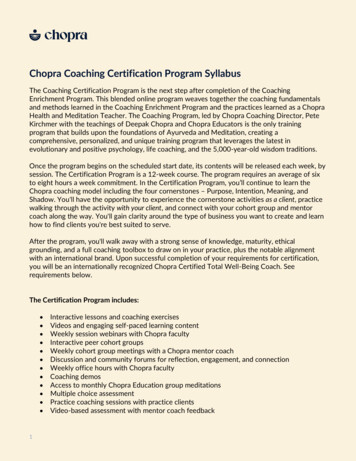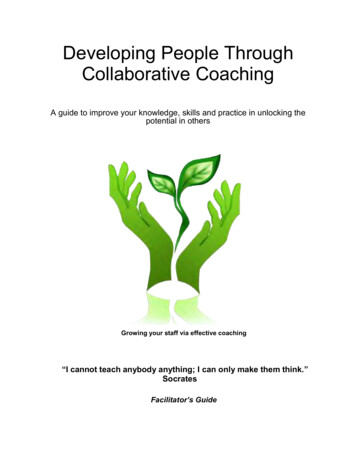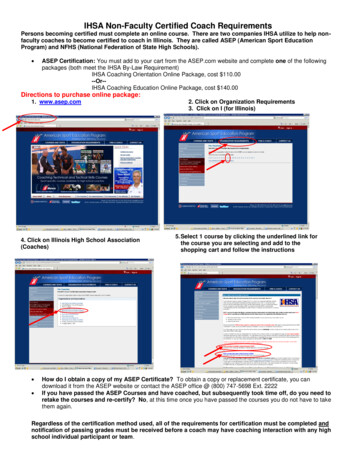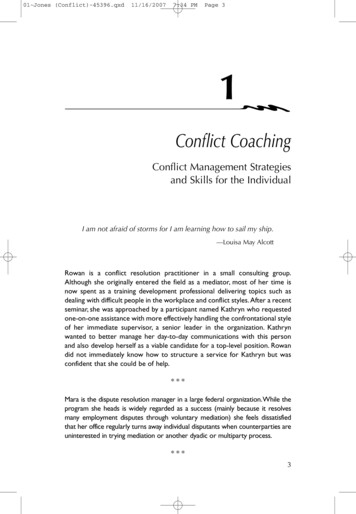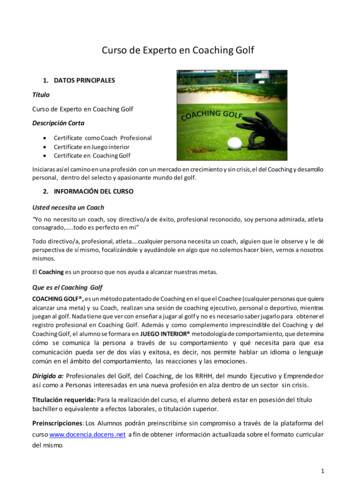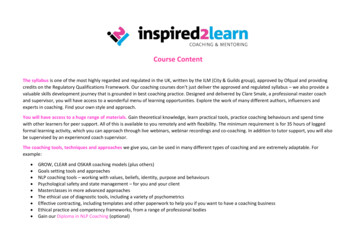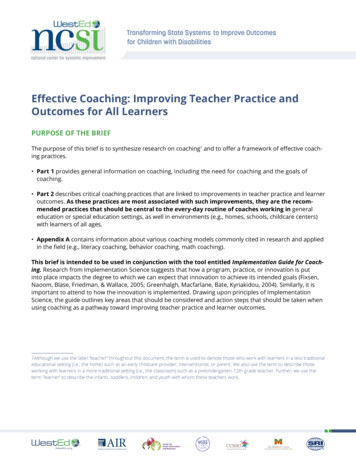
Transcription
Coaching To ImprovePerformance
Coaching To Improve PerformanceCoaching To Improve Performance - IntroductionWelcome to Coaching to Improve Performance.Coaching is one of those words that is buzzing around businesses, however, it is rarely representedcorrectly and at best given lip service in terms of putting it into practice.Many businesses are founded on an autocratic hierarchy which tells its workers what to do rather thangrowing the individual talents of its employees for the benefit of the customers and its profits.Coaching other people is a very satisfying and rewarding task as it enables people to create changethrough learning. It helps people to be more, do more, achieve more and above all contribute more.This manual will seek to put right the misconceptions about coaching and equip you with the skills to trulydevelop others and gain satisfaction from doing so.The manual can be used as a reference manual or read from cover to cover.In it you will find information on all aspects of coaching provision. You will also be able to test youreffectiveness using the self-analysis questionnaires and by utilising the tried and tested methodshighlighted.Remember, from little acorns large oak trees grow!MTD Academy2
Coaching To Improve PerformanceCoaching – How Do I Rate As A Coach? Self-AssessmentQuestionnaireRead through the questions and circle the number which represents your behaviour as a coach:To what degree do I .1.Set specific performance standards and expectations for myemployees?2.Help employees set their own goals?3.Carefully plan for a coaching session by determining what I want to sayand what I want the outcome to be?4.Address specific behaviour rather than attitude or evaluatejudgements?5.Begin a coaching session by expressing empathy and understanding?6.Use active listening techniques such as paraphrase or restatement toensure clear understanding between myself and my employee?7.Give the employee opportunities to offer suggestions?8.Use open-ended questions to encourage employees to open up andexpress themselves?9.Demonstrate support by using praise and agreement to reinforcewhat the employee says?10. Create an open environment that encourages collaborative, two waycommunication?11. Guide employees in a problem-solving process rather than tell themwhat to do?12. Help employees develop a performance improvement plan?13. Meet regularly with employees to monitor their performanceimprovement efforts?14. Reward employees for achieving the desired results?15. Explain how what they do fits into the “big picture”?16. Communicate to employees that I have confidence in them and theirabilities?17. Prioritize areas for improvement rather than address everything atonce?18. View coaching as one of my most important managerialresponsibilities?19. Show a genuine interest in the employees during a coaching sessionthrough positive, non-verbal behaviour?20. Give positive reinforcement to an employee for improving performanceeven if the employee has not yet met my expectations?MTD AcademySmallLargeDegreeDegree1 2 3 4 5 61 2 3 4 5 61 2 3 4 5 61 2 3 4 5 61 2 3 4 5 61 2 3 4 5 61 2 3 4 5 61 2 3 4 5 61 2 3 4 5 61 2 3 4 5 61 2 3 4 5 61 2 3 4 5 61 2 3 4 5 61 2 3 4 5 61 2 3 4 5 61 2 3 4 5 61 2 3 4 5 61 2 3 4 5 61 2 3 4 5 61 2 3 4 5 63
Coaching To Improve PerformanceScoring:Add up the values of all circled numbers.Then use the following scale to determine your success as a coach:101-12081-100You are a top-notch, supportive performance coachYour coaching skills need some fine tuning61-80You need to focus on a few areas for improvement41-60Coaching skills improvement needs to be a top priority0-40You need to closely examine your basic managementpracticesMTD Academy4
Coaching To Improve PerformanceWhat is Coaching?A dictionary definition for a coach is:“A vehicle that takes a person from where they are to where they want to be”This can be true of the many people transportation vehicles and the personal coach who helps an individualachieve their goals where they could not have done by their own actions solely.Put more simply, coaching is a conversation, or series of conversations, one person has with another. Thecoach intends to produce a conversation that will benefit the other person, the coachee, in a way thatrelates to the coachee’s learning and progress. Coaching conversations are not restricted a workenvironment and can happen in many different ways and circumstances.Coaching has many forms and falls within many different aspects of human activity. There are sportscoaches, musical coaches, life coaches, voice coaches, time management coaches, to name a few. In thisday and age it appears that there is a coach available to help you with everything that you do.The person who decides whether a conversation was a coaching conversation or not is normally the personbeing coached. If someone acknowledges the following to be true after a conversation they would probablyaccept that it was coaching: The focus of the conversation was primarily themselves and their circumstancesTheir thinking, actions and learning benefited significantly from the conversationThey were unlikely to have had those benefits in thinking or learning within that time frame if theconversation hadn’t happenedSo when we apply these simple principles, we realise we have been coaching each other for ages. Forgenerations, whether over the garden wall a cup of tea or a beer in the pub we have all talked about whathappens in our lives. We share our troubles and our dreams. We listen to each other and advise eachother. Sometimes this process really helps. Maybe we realise a solution, make a decision, or perhaps justfeel better as a result of having the conversation.MTD Academy5
Coaching To Improve PerformanceWhere Are You Already Coaching?Read through the following, which do you do regularly? Give friends or colleagues advice Listen to others’ problems, to help and support them Explain to other people how to do something better Train others in new knowledge and skills Manage the work of others Give other people feedback or observations of their behaviour so that they can improve doing insomething Conduct job appraisals, or assessments of people’s work performanceMTD Academy6
Coaching To Improve PerformanceWhere Does Coaching Come From?The most recognised forms of coaching come from the sporting world. Having evolved over thousands ofyears, the figure of a sports coach working alongside top athletes is accepted without question. There mayseem to be a contradiction in having someone who can't do what you can do, as well as you can do it, helpyou to improve. Andre Agassi's coach can't play tennis like Agassi does, and yet he plays a vital role inimproving Agassi's game. So why does Agassi get help from a lesser player?The reason is quite simple: because coaching is proven to work. It improves the results an individual isgenerating. A tennis coach needs coaching skills more than they need to be a good tennis playerthemselves. By applying principles of observation and feedback, sports coaches can make the differencebetween a world-beater and an 'also- ran'.Strangely, where someone has all the skills needed to produce a result themselves, they can't always helpsomeone else to do it. For example, a world-class tennis player might have real difficulty in coachingsomeone else to the same standard. This is because the perspectives and skills of a coach are essentiallydifferent from those of a tennis player. If a tennis player wants to become a great coach, they must beginto focus on developing coaching behaviours and skills. It's not enough to be able to 'do' - you have to beable to coach.The same principle applies in business. Coaches work alongside individuals to help improve theirperformance at work, regardless of whether or not they could do that work themselves. What a coach cando, is help someone see opportunities for improvement, as well as practical ways forward.MTD Academy7
Coaching To Improve PerformanceHow To Approach CoachingThere are two main differences in the way that coaching can be approached:Firstly, there is the ‘teacher’ who’s method is to tell what should and should not be done. Although this mayaddress the immediate situation, it restricts development to a fairly low level and can introduce dependencewhen future situations arise, e.g.: “Every time there is a perceived problem, all I have to do is ask someoneand they will provide me with the answer”. If you think back to the days of your education, you maywell believe that much of what you were taught has long disappeared from the memory. This is becausebeing ‘taught’ in the traditional ‘teaching’ way is unlikely to enhance our ability to learn and develop.Secondly, there is the preferred method, which focuses on a very different approach.By assisting another person with their own learning you effectively reduce their dependence on the answerbeing given, and increase their own ability to learn. You could summarise this:By the use of open questions, you can allow someone to search for the options available to any givensituation and establish their goal. This is sometimes referred to as GROW (Goals, Reality, Options, Will)and is covered in more detail later on in this guide.Although these methods are very different in approach, you must remember that the two can be quiteclosely linked. Both options will provide you with knowledge, which is of course essential. However thesecond option will enhance your ability to think for yourself. The coachee will now be in a position to dosomething they thought they were previously unable to do.Coaching for AbilityAlthough the focus of coaching is on learning, the learning should be for a purpose. Thus enabling thecoachee to develop, improve and possibly gain a new ability. In order to do this, they need to learn newknowledge and new ways of thinking and acting.Creating the RelationshipThe way in which we act with people can have a big impact on their effectiveness in their place of work.The relationship between the coach and coachee will therefore have a direct influence on the value of thecoaching sessions. It is safe to say that if you, as the coach, are feeling uncomfortable in the presence ofthe coachee it will have a detrimental effect on the learning. The same effect could also be seen if the rolesare reversed.Trust will play a very large part in the relationship building, the key point must therefore be two-way openand honest communication.Some relationships will just happen and others will need developing. This is a fact of life. Both parties willneed to establish what it is that they are expecting from the other person, and what they will need tocontribute to the relationship themselves. It is very much a two-way thing and there may therefore be manyexpectations on either side.One of the dangers is that a breakdown in the relationship could arise if one party is more giving than theother, e.g.: one person may regularly put themselves out to assist the other in various circumstances, butshould these actions not be reciprocated ‘when the boots on the other foot’ the other person may feeluncomfortable or dissatisfied with the situation.What normally happens is that the first impression you give becomes the expected approach, as arelationship has already been formed. We must be careful not to make assumptions at this stage andMTD Academy8
Coaching To Improve Performanceshould approach all interactions with integrity.The purpose of the coaching relationship is to increase the learning and aid the development of theindividual. It is imperative that both parties know where they stand, what they expect to happen and bywhen. It is absolutely necessary, therefore, that the appropriate actions are followed through on what hasbeen agreed.Coaching Effective LearnersWith the introduction of performance management, there is a very strong emphasis on taking ownership ofour own self-development. Effective learners will use all the options available to ‘manage’ their learning andnot just rely on ‘on the job experience’ or being nominated for a course to attend.We must as an organisation support this approach and encourage ownership and responsibility by allindividuals, as if it were second nature. Our main objective being to embed a structured and planneddevelopment process in such a way that it matches that of the desired goals.CommunicationTo pay attention to the communicational preferences of the other person is often called effectivecommunication.Consideration of how people prefer to communicate normally leads to a positive response, and is often theway in which they feel more comfortable in communicating themselves. It is understandable, therefore, thatto communicate in an alien way could hinder the effectiveness of the coaching session.So how do we know the method we should adopt? Different people will have different methods andpreferences with regard to communicating. There are probably endless possibilities.Working to the coachee’s agenda along with the use of effective questioning will assist you to: build trust (open and honest communication)show a visible interest in their performance (active listening and reflective questioning)help identify their needs (ongoing support)establish and identify their goal (raise awareness and generate responsibility)An important aspect of communication within coaching is to provide feedback. To provide open, honest andconstructive feedback can increase our learning capabilities, and indeed help us to learn very quickly.MTD Academy9
Coaching To Improve PerformanceHow Does Personal Coaching Happen?A personal coach will often work within arranged coaching sessions. The coach will normally use a blend ofobservation, talking, listening, questioning and reflecting back to the individual they are working with. If thesituation or circumstances are suitable, a coach might also use other media, such as telephone, or e-mail.Coaching might consist of two people talking in a room about things the coachee wants to change. This issometimes called 'off-line' coaching. It might also be one person observing another person doingsomething, e.g. talking to customers or colleagues, then discussing that afterwards. This can be called online coaching.Other coaching conversations might easily happen outside a formal coaching session. For example, acasual discussion around a challenging situation or goal may easily produce a conversation in which theindividual receives coaching.Whether coaching happens in the workplace or outside, the two activities can easily merge into the samething. It's often impossible to separate work from life anyway. People's lives don't package themselves intoneat little bundles-job, home, money, health, etc. Our lives seem to contain themes that run through themlike common-coloured threads. If you're not happy at work, that's likely to show up somewhere else. Ifyou're not feeling healthy or full of energy, then that's likely to be mirrored elsewhere, e.g. in yourrelationships or social life.MTD Academy10
Coaching To Improve PerformanceThe Coaching RelationshipThe role of coach provides a kind of support distinct from any other. A coach will focus solely on anindividual's situation with the kind of attention and commitment that the individual will rarely experienceelsewhere.If you imagine yourself being coached, you will perhaps appreciate why so many people engage theservices of a coach. This person, your coach, will listen to you, with a curiosity to understand who you are,what you think and generally how you experience the world.Your coach will reflect back to you, with the kind of objective view that creates real clarity. Duringconversations, your coach will encourage you to rise to challenges, overcome obstacles and move intoaction.What's most important during that conversation is you, your success, happiness and ultimate fulfilment.Having worked to establish exactly what you want to achieve from coaching, those goals and objectivesbecome the focus for the conversation. As a consequence, the only agenda happening in the conversationis your agenda, which your coach will often guard more closely than you do. When you're ready to quit, nolonger care that you wanted to get that job, lose that weight, or have that lifestyle, your coach stayscommitted to those goals.When things don’t go well, your coach supports you. When you experience success, your coachacknowledges your achievements. Your coach will also help you to pinpoint exactly what you did thatworked so well, so that you can do it again. A coaching relationship is like no other, simply because of itscombination of objective detachment and commitment to the goals of the individual.Little wonder then that so many people are finding that coaching relationships can help them develop andlearn in ways that enable them to have or achieve what they really want.MTD Academy11
Coaching To Improve PerformanceLearn To Coach By “Being Coached”One of the best ways to learn how to be a good coach is to be coached. You will experience what it feelslike to be a coachee. You will understand what works and what doesn't, what feels right and what feelswrong. Surprisingly, that might not always be what you expect. For example, as a coach, silence can beuncomfortable, whilst for a coachee, the same silence can feel wonderful.A sense of rapid progress during a conversation can feel great for the coach, and yet turbulent for thecoachee. So if you're serious about developing your coaching skills, I recommend you get some sort ofcoaching as part of your development.As well as helping you develop as a coach, who knows, you might just find there are other benefits for yourpersonal goals as well!MTD Academy12
Coaching To Improve PerformanceCoaching: In BusinessCoaching is now big in business. Many organizations have come to realize that they can improve both theperformance and motivation of their people through coaching. Increasingly, a 'coaching' style ofmanagement is preferred to the more traditional approaches of 'command and control'.Instead of managers directing people, giving detailed instructions for what to do, and when to do it, theyfocus more on encouraging people to think for themselves. When problems arise, those managers whocoach don't automatically jump in and solve them. Instead, they challenge others to resolve situations. Thesemanagers provide support, feedback and guidance - but rarely answers.Managers who coach often place as much importance on the development of people reporting to them, asthe tasks those people are performing. For the manager, this means fewer queues of people at their deskasking what to do next (and much less worry if the manager wants a two-week vacation). More of themanager's focus is on establishing conditions in which people can perform independently of the manager.Creating these conditions means more time is spent on activities such as objective setting, one-to-onemeetings and team briefings. One-to-one meetings can now become coaching sessions, as the manageradopts a more supportive, challenging and developmental approach.Within team meetings, the manager can use the coaching skills of listening, questioning and goal setting toencourage the group to take responsibility for situations. Over time, colleagues learn more, perform better,and are generally more motivated by this nurturing style of leadership. As they become used to themanager's expectations of them, they begin to automatically respond to situations with more responsibilityand empowerment.Managers who coach improve productivity, morale and job satisfaction for their colleagues. Such managers,in turn, find that people are less dependent upon them, which often reduces pressure, or frees up time toconcentrate on other priorities. As more businesses go multi-site or even global, the distance betweenmanagers and their teams widens. Here, a coaching style is essential for both sanity and success. As acoaching manager increases people's independence, they directly reduce the dependency on themselves tobe on-site, supervising what's happening.MTD Academy13
Coaching To Improve PerformanceExecutive CoachingOrganizations are now willing to invest in personal coaching for their senior managers and executives. Byimproving the performance of the most influential people within the organization, we are able to improveresults at an organizational level. In short, we create a positive influence on people who have influence.Senior managers encourage typical behaviours and ways of being within the rest of their organization. Whatthey say and how they behave establishes similar standards for people who work for them.Executive coaching is often done by coaches operating from outside the organization, whose services arerequested for an agreed duration or number of coaching sessions. Increasingly, personal coaches are alsobeing trained internally, as organizations realize the opportunity this presents. Internal coaches normallycost less, and can operate very effectively because of their knowledge of the operation.Within business, situations that benefit from personal coaching might include the following: A manager with potential has been promoted and is having difficulty performing in the new roleAn individual is being groomed for senior management and needs to gain skills or experience beforethey are able to make that moveAn individual has relationship issues that are creating problems at an organizational levelAn organization has decided to align management behaviours to a set of core values, e.g. integrity,collaboration or innovation. Some managers will need coaching in these specific areasFor example, during coaching a marketing director realizes he acts competitively against the sales director.Because of the competition he feels, he encourages his own department to withhold support andinformation from the sales department. This causes him problems. Last year he mistimed the launch of arange of sports gear - bringing it out on exactly the same day as their main competitors. Sales could havetold him this was a mistake, but they heard about the launch too late. During coaching, the marketingdirector improves his relationship with the sales director, and encourages his department to adopt a morecollaborative style.This results in marketing telling sales more about their plans for the year, and what type of products theyare thinking of launching. As the flow and exchange of information improves, so does the quality of productsand sales campaigns.MTD Academy14
Coaching To Improve PerformanceThe Manager As A CoachThe manager must be seen as a focus of support not as a threat or a cop. Here lies the problem, as themanager traditionally holds the paycheque, the decision to whether you succeed or fail and also whetheryou keep your job. This situation is fine as long as you see motivation as a carrot and stick exercise.However, for coaching to really work, the relationship between the coach and the coachee must be one ofpartnership through endeavour, of trust, of safety and of minimal pressure. The carrot and the stick haveno place in this arrangement.Can a manager, therefore, be a coach at all? Yes, but it demands the highest qualities of that manager:empathy integrity and detachment, as well as a willingness, in most cases, to adopt a fundamentallydifferent approach to his staff. He will also have to find his own way, for there are few role models for himto follow, and he may even have to cope with initial resistance from some of his staff, suspicious of anydeparture from traditional management. They may fear the additional personal responsibility implicit in acoaching style of management. These problems can be anticipated and generally are easily coachedaway.The polarities of management or communication style with which we are familiar place an autocraticapproach on one end of the spectrum, and laissez faire and hope for the best on the other.When you were a little child, your parents told you what to do, and scolded you when you didn't. When youwent to school, your teachers told you what to do, and caned you if you didn't. When you joined the army,the sergeant told you what to do, and God help you if you didn't, so you did! When you got your first job,your boss told you what to do too. So when you reached a position of some authority, what did you do? Youtold people what to do, because that is what all your role models had done. That is true for the majority ofus: we have been brought up on telling, and we are very good at it.The attraction of telling or dictating is that, besides being quick and easy, it provides the dictator with thefeeling of being in control. This is, however, a fallacy. The dictator upsets and de-motivates his staff, butthey neither dare show it nor offer feedback, which would not have been heard anyway. The result is thatthey are subservient in his presence but behave differently when his back is turned, with resentment, withpoor performance at best, maybe by downing tools or even by sabotage. He is anything but in control – heis deluding himself.RecallThere is yet another problem with the dictating end of the traditional management spectrum: the problem ofMTD Academy15
Coaching To Improve Performancerecall. Put simply, we do not remember very well something we are told. The table below prove this.It depicts a piece of research carried out by IBM, but has been repeated more recently by the Post Office.A group of people were divided randomly into three sub groups, each of which was taught something quitesimple. This was the same thing in each group but taught in three different ways. The results speak forthemselves. One thing that they show which particularly concerns us, however, is how dramatically recalldeclines when people are only told to do something.ToldTold andshownTold, shownandexperiencedRecall after 3 weeks70%72%85%Recall after 3 months10%32%65%PersuadesIf we move along the traditional management spectrum to the right we come to selling or persuading. Herethe boss lays out his good idea and attempts to convince us how great it is. We know better than tochallenge him, so we smile demurely and carry out his instructions. Nicer maybe, if a bit phoney, and itgives the appearance of being more democratic. But is it really? We still end up doing exactly what the bosswants, and he gets little input from us. Nothing much has changed.DebatesWhen we get further along the line to discussing, resources are genuinely pooled and the good boss maybe willing to follow a path other than his own option, provided it is going in the right direction. Sir JohnHarvey- Jones said:If the direction everyone else wants is not where I thought we should go, I'll go . once the thing is rolling,you can change direction anyway. I may see they were right or they may realize it isn't the right place to beand head towards my preferred course, or we may both come to realize that we would rather be in a thirdalternative. In industry, you can only move with the hearts and minds.Attractive as democratic discussion may be, it can be time consuming and result in indecision.AbdicatesThe far end of the scale, just leaving the subordinate to get on with it, frees the manager for other dutiesand gives the subordinate freedom of choice. It is, however, risky for both. The manager has abdicated hisresponsibility, although the buck still stops with him, and the subordinate may perform poorly due to a lackof awareness of many aspects of the task.MTD Academy16
Coaching To Improve PerformanceManagers sometimes withdraw with good intent, wishing to force subordinates to learn to cope with moreresponsibility. This strategy seldom serves its purpose, because if the subordinate feels obliged to takeresponsibility, rather than choosing to, his personal ownership remains low and his performance will notreflect the benefit of the self-motivation which the manager hopes to generate.CoachingThe majority of managers will position themselves on the scale somewhere between these extremes, butcoaching lies on a different plane altogether and combines the benefits of both ends with the risks ofneither.In responding to the manager's coaching questions the subordinate becomes aware of every aspect of thetask and the actions necessary. This clarity enables him to envisage the near certainty of success, and soto choose to take responsibility. By listening to the answers to his coaching questions, the manager knowsnot only the action plan but the thinking that went into it. He is now far better informed than he would be ifhe told the subordinate what to do, and therefore has better control of what is going on.Since the dialogue and the relationships in coaching are non-threatening and supportive, no behaviourchange occurs when the manager is absent. Coaching provides the manager with real not illusionarycontrol, and provides the subordinate with real not illusionary responsibility.The Role of the ManagerWhat this throws up is, 'What is the role of a manager?'Many managers too frequently find themselves fire-fighting, struggling to get the job done. By their ownadmission they are unable to devote the time they feel they should to long-term planning, to visioning, totaking the overview, to surveying alternatives, the competition, new products and the like. Most importantly,they are unable to devote the time to growing their people, to staff development. They send them on atraining course or two and kid themselves that that will do it. They seldom get their money's worth.So how can managers find the time to coach their staff? It is so much quicker to dictate. The paradoxicalanswer that if they coach their staff, the developing staff should much greater responsibility, freeing themanager from fire-fighting not only to coach more but to attend to those overarching issues that only he canaddress
Coaching To Improve Performance MTD Academy 4 Scoring: Add up the values of all circled numbers. Then use the following scale to determine your success as a coach: 101-120 You are a top-notch, supportive performance coach 81-100 Your coaching skills need some fine tuning 61-

